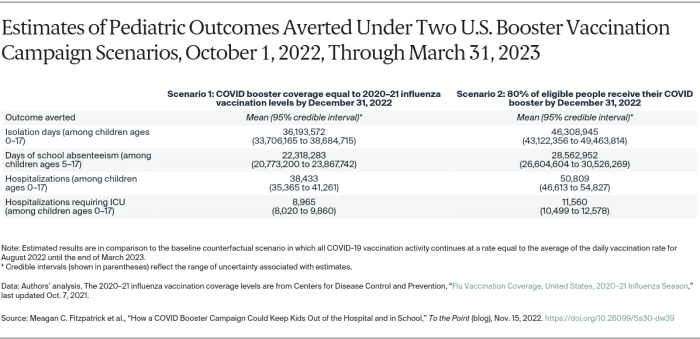This post was originally published on this site
If 80% of children ages 5 and older get their COVID booster shots by the end of 2022, it could prevent about 29 million missed days of school and almost 51,000 hospitalizations, according to a new report.
And if COVID booster coverage simply matches 2020-21 flu-vaccination levels by year’s end, it would prevent about 22 million missed school days, said the report published by the Commonwealth Fund.
“We expand our previous analysis to include the impact on pediatric hospitalizations, pediatric isolation days, and school absenteeism (among children ages 5 to 17), demonstrating both the health benefits of vaccination and the importance of vaccination uptake for maintaining uninterrupted in-school education,” the authors wrote in the report.
The number of days absent from school was calculated based on five days of required isolation for children in that age group who experience mild symptomatic illness and 10 days for children who have severe illness or require hospitalization.

Source: Commonwealth Fund
An effective booster campaign would considerably reduce the strain on pediatric hospitals this winter, many of which are currently seeing high numbers of children with respiratory syncytial virus, known as RSV, and the flu, the authors wrote.
“Throughout the pandemic, children have experienced direct health burdens as well as enormous upheaval in their personal and educational lives,” the report said. “Accelerated vaccination campaigns that achieve high coverage across all ages have the potential to prevent a possible imminent surge in COVID-19, protecting children both directly and indirectly and providing them with additional stability in terms of school attendance and other social engagement.”
The report comes as known U.S. cases of COVID are climbing again for the first time in a few months. The daily average for new cases stood at 39,459 on Monday, according to a New York Times tracker, up 4% versus two weeks ago.
Cases are rising the most in the Southwest, led by Arizona, Colorado, Nevada and New Mexico — states that are also seeing hospitalization numbers climb by more than 30% in the last two weeks.
The daily average for U.S. hospitalizations was up 1% at 27,662.
On a brighter note, the daily death tally continues to fall and is down 13% to 302 from two weeks ago.
Coronavirus Update: MarketWatch’s daily roundup has been curating and reporting all the latest developments every weekday since the coronavirus pandemic began
Other COVID-19 news you should know about:
• China’s ruling party called for strict adherence to its hard-line “zero-COVID” policy Tuesday in an apparent attempt to guide public perceptions after regulations were eased slightly in places, the Associated Press reported. The news may disappoint Chinese citizens who have clashed with police and COVID workers to show their frustration over lockdowns and restrictions on movement. The People’s Daily, the Communist Party’s flagship newspaper, said in an editorial that China must “unswervingly implement” the policy that requires mass obligatory testing and places millions under lockdown in an attempt to eliminate the coronavirus from the nation of 1.4 billion people.
• Japan will lift a ban on international cruise ships that has lasted more than two and half years, transport officials said Tuesday, the AP reported separately. The ban was imposed following a deadly coronavirus outbreak on the cruise ship Diamond Princess at the beginning of the pandemic. The Transport Ministry said cruise-ship operators and port authorities associations have adopted antivirus guidelines and that Japan is now ready to resume its international cruise operations and to receive foreign ships at its ports.
• Cambodian Prime Minister Hun Sen tested positive for COVID-19 after meeting with world leaders, including President Joe Biden, at a summit of Southeast Asian nations last week, the Wall Street Journal reported. Mr. Hun Sen held one-on-one talks with Biden on Saturday on the sidelines of the regional discussions in Phnom Penh. Biden — who is on a five-day trip to Asia to attend a series of summits — then traveled to Bali, Indonesia, where he sat down on Monday with Chinese leader Xi Jinping for a face-to-face meeting that stretched over three hours.
• Australia will overturn a three-year ban on tennis player Novak Djokovic entering the country, paving the way for the former top-ranked player to take part in the 2023 Australian Open, CNN reported, citing a source with direct knowledge of the matter. Australian Immigration Minister Andrew Giles will lift the ban, the source said.
Here’s what the numbers say:
The global tally of confirmed cases of COVID-19 topped 635.6 million on Monday, while the death toll rose above 6.61 million, according to data aggregated by Johns Hopkins University.
The U.S. leads the world with 98 million cases and 1,074,691 fatalities.
The Centers for Disease Control and Prevention’s tracker shows that 227.8 million people living in the U.S., equal to 68.6% of the total population, are fully vaccinated, meaning they have had their primary shots.
So far, just 31.4 million Americans have had the updated COVID booster that targets the original virus and the omicron variants, equal to 10.1% of the overall population.

